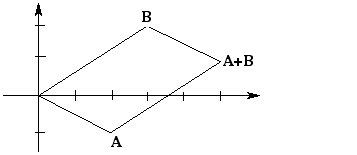- Let A = (a,b) and B = (u,v) be two points in the plane.
- The direction indicator of the line joining A and B is D = B - A.
- In terms of the coordinates, D = (u,v) - (a,b) = (u-a, v-b).
(See Figure 8.3 in the text.)
- So, if a person starts travelling in a straight line from A, and covers the distance from A to B in 1 unit of time, then the person's position at time t is given by the formula
P(t) = A + tD, or equivalently P(t) = A + t(B - A).
We also refer to this formula as the parametric form of the line.
- A line given parametrically with the same starting point A and direction indicator
2D= (2(c-a),2(d-b)),then it is the same line, but the traveler is moving twice as fast.
(Also see Exercise 8.2.17, a recommended review problem).
- Two lines with the same direction indicator are parallel (or the same …).
Similarly, a line with direction indicator kD, where k is a real number, is parallel to a line with direction indicator D (unless it is the same line).
- Find the direction indicator and the
parametric form of each of the following lines:
- The line joining (-1,3) and (2,1).
- The line through (1,5) parallel to the line found in part a.
- The line joining (a,b) and (c,d).
(Related to Exercise 8.2.24, a recommended review problem.)
- Let A = (a,b) and B = (c,d) be two points in the plane.
- Then A+B = (a+c, b+d). This is shown in the sketch below, for A= (2-1) and B= (3,2).

- What are the direction indicators of the following lines? (Try it for the particular points
A= (2-1) and B= (3,2) and also in general, i.e., for abstract points (a,b) and (c,d).) - The line joining (0,0) and A.
- The line joining B and A + B.
- The line joining (0,0) and B.
- The line joining A and A + B.
- Which of the above pairs of lines are parallel? What kind of quadrilateral
is formed by the four points (0,0), A, B, and A + B?
(Also see Exercise 8.2.14 and Exercise 8.2.19, a recommended review problem.)
- Let a line be given parametrically, with direction indicator D = (c,d).
- If the starting point is A = (a,b), then the position at time t is:
P(t) = A + tD. - For practice, sketch this with A= (1,3) and D = (2, -1).
Calculate P(0) and P(1) in this case. - Use the answer from the previous part to calculate the slope of the line.
- Calculate P(0) and P(1) for P(t) = A + tD, where A = (a,b) and D = (c,d).
- Use the answer from the previous part to calculate the slope of the line.
(Simplify your answer as much as possible.)
(Also see Exercise 8.2.18)
- If the equation of a line is given as y = mx + b, (this is called the slope-intercept form of the equation) we can represent the line parametrically as follows:
- Find two points on the line (for instance by substituting two different x-values and then calculating the corresponding y-values).
- Use the methods of I. above to find the parametric form.
- So, the conclusion from III and IV is that it's possible to go back and forth between the two ways of describing a line.
- By definition, the norm of P is
 .
. - If we think of P = (x,y) as representing a point of the plane, then the Pythagorean theorem tells us that the norm of P is the distance from (0,0) to P.
- If we think of a vector D as being an arrow, then the norm ||D|| is just its length.
- So, in general, we need an ordered pair of numbers to specify a vector, but its norm is just a number.
- If P = (a,b) and Q = (c,d) are two points, then ||Q - P||, the norm of the difference, is the distance from P to Q:
- Q - P = (c-a, d-b), so that: